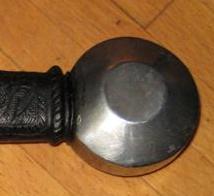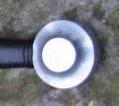| Author |
Message |
Julien M

|
 Posted: Fri 15 Jan, 2010 6:08 am Post subject: shaping a pommel Posted: Fri 15 Jan, 2010 6:08 am Post subject: shaping a pommel |
 |
|
Hi Gents,
I'm in need of advice as my metal working skills are very basic (almost non existent would be even more appropriate  . .
I'd like the pommel of this dagger below (pict 2) to match my A Crecy pommel (pict 1). I'm sure it is fairly easy to achieve with the proper tools (basically I'd just like to hollow the borders on both sides).
How would you do that? What tools would you use? (remember I don't have a workshop, I work in the guest room in my house so no factory sized machinery is allowed 
I have a dremel, but even with the coarsest of my wheels I've barely scratched the surface...I'm thinking of buying a little benchtop belt sander. Would that be appropriate for that kind of job? (most seem too big to shape such fine details...).
I'm looking forward to hear your advices.
Cheers,
J
 Attachment: 11.54 KB Attachment: 11.54 KB

 Attachment: 11.27 KB Attachment: 11.27 KB

|
|
  |
 |
|
JG Elmslie
Industry Professional
|
 Posted: Fri 15 Jan, 2010 7:02 am Post subject: Posted: Fri 15 Jan, 2010 7:02 am Post subject: |
 |
|
ouch. good luck.
it'll depend on the steel. if it's a mild steel, you're probably ok. if it's hardened carbon, I think the technical term for what you're wanting is "rather you than me".
and a dremel's likely to do pretty limited work. they're only dinky things, after all.
from there, are you able to get the pommel off? if so, you're probably more likely to be able to work it well. if not, then the grip is going to get in the way a hell of a lot, and likely to end up a mess.
if you can get it off, then my personal approach, being a masochist who enjoys using hand tools, would be to clamp it into a soft-jawed vise, and then use round or half-round files in Bastard, 2nd Cut, and Smooth grades, and create the hollow-curve that way. I actually prefer it to using a powered belt sander, for control and workmanship. (Though that may be 'cos my linisher's a bit simple, and I've yet to build an ohgodhelp horsepower super-belt-o-matic-2000 belt sander o' doom(tm).  ) )
once you've filed the basic concave profile to shape with the files, the smooth file should have given a slightly scruffy satin finish, I'd then use a split dowel clamp of a matching diameter to the filed profile, with emery paper in it, and work up from P120 to P240, P400, P600, P1000 or P1200 then P1200 wet, then onto a Jeweller's micron paper by hand, and polish the peice up to a mirror finish that way.
(split dowel clamp, btw: take a peice of dowelling6-8 inches long, and saw it down the centreline, plane the faces smooth if you have to, then drill two holes in it and make/buy a pair of screws to fit in. put the two peices of dowel together, take a length of emery paper to fit in between the two peices, and then tightly roll it around the rod, and back into the slot, and then screw down the screws to clamp it in place. the dowel gives a clean sectional profile, letting to sand the curve each time dead simple. )
|
|
   |
 |
Sean Flynt

|
|
   |
 |
Maurizio D'Angelo

|
 Posted: Fri 15 Jan, 2010 10:53 am Post subject: Posted: Fri 15 Jan, 2010 10:53 am Post subject: |
 |
|
I agree with Sean,
Some advice. A good wheel size without excessive wear, when cruising at a peripheral speed of 30-33 meters per second. Here the formula for calculating the number of revolutions per minute rel diameter of the wheel. Here is an example.
Peripheral speed = 30 Number of fixed (for the type of grinding wheel shown by Sean, do not exceed this value)
Diameter grinding wheel diameter = 15 (value expressed in mm.)
N = speed (60 x 1000 x 30): (15 x 3.14) = 38,000 rpm.
I think the Dremel is running at max 30,000. This means that using a grinding wheel of 10 mm is not convenient for the grinding wheel wear. One other thing, an electric grinder discs, can remove excess material, then finish with the Dremel. The pommel, are typically medium carbon content, not heat treated.
Good job. 
Ciao
Maurizio
|
|
   |
 |
Sean Flynt

|
|
   |
 |
Douglas S

|
 Posted: Fri 15 Jan, 2010 2:00 pm Post subject: Posted: Fri 15 Jan, 2010 2:00 pm Post subject: |
 |
|
Just curious: How would a pommel such as this be hot-worked in a period fashion?
There's not that much to grab onto.
|
|
  |
 |
Julien M

|
 Posted: Fri 15 Jan, 2010 2:02 pm Post subject: Posted: Fri 15 Jan, 2010 2:02 pm Post subject: |
 |
|
Thanks guys!
I did try that dremel attachment a couple of days ago...I simply didn't try hard enough...
Just gave another try with it and got the motion right as well as the right amount of pressure...and it does swallow quiet a lot of material. I know now that I can achieve my project with it, then finish by hand with a file then sandpaper...if all goes well as there is plenty of opportunities to ruin it too 
I did experience that with dremel attachment too Sean, one of my cutting wheels simply shattered and I found bits and pieces everywhere...I was not wearing any protective gear but was lucky...it served its purpose as a valuable warning for me...
This dagger is quiet a looker I think (it's the sword hilted dagger from MRL, made a carved grip for it here:
http://www.myArmoury.com/talk/viewtopic.php?t...ighlight=) but the balance is nonsense (the pommel used is the same as the MLR coustille, with a blade only half the lenght...so the point of balance is at the middle of the grip...the natural motion to strike would be to hammer your foe with the pommel, as the blade presence is simply non existent. In short, removing a lot of mass off the pommel makes perfect sense, and the knife should benefit from that aesthetically too).
Will post pictures when it's done (making a scabbard for it too),
J
|
|
  |
 |
|
Steven McIntyre
Location: Coquitlam, BC, Canada Joined: 03 Sep 2006
Posts: 45
|
 Posted: Fri 15 Jan, 2010 2:39 pm Post subject: Posted: Fri 15 Jan, 2010 2:39 pm Post subject: |
 |
|
| Julien M wrote: | | ...but the balance is nonsense (the pommel used is the same as the MLR coustille, with a blade only half the lenght...so the point of balance is at the middle of the grip...the natural motion to strike would be to hammer your foe with the pommel, as the blade presence is simply non existent. |
haha yeah I'm looking for a small spherical pommel for the same reason. I bought the dagger because i loved how it looked with the big wheel pommel, so I hope this works out for you.
Steve
~PER ARDUA~
|
|
  |
 |
Jean Thibodeau

|
 Posted: Fri 15 Jan, 2010 8:46 pm Post subject: Posted: Fri 15 Jan, 2010 8:46 pm Post subject: |
 |
|
| Julien M wrote: |
I did experience that with dremel attachment too Sean, one of my cutting wheels simply shattered and I found bits and pieces everywhere...I was not wearing any protective gear but was lucky...it served its purpose as a valuable warning for me...
J |
I find that stacking a number of cutting wheels together slows down how deeply they cut at each pass making for greater control and the stacked wheels support each other a bit so they don't turn to dust as easily.
What the cutting wheels really don't like is any side pressure when trying to cut anything but in a strait line.
I like the cutting wheels as the abrasive really cuts aggressively while the other stones used on dremel tool heads just don't seem very effective on steel of any hardness.
The cutting wheel are like a Star Wars light sabre when used as intended to cut of a section off steel, they also work great for doing decorative file work but one can easily muck up the work if one's hand isn't 100% steady and in control as well the rotation of the wheel can take you further or deeper than you want to go.  
You can easily give up your freedom. You have to fight hard to get it back!
|
|
  |
 |
|
|
You cannot post new topics in this forum
You cannot reply to topics in this forum
You cannot edit your posts in this forum
You cannot delete your posts in this forum
You cannot vote in polls in this forum
You cannot attach files in this forum
You can download files in this forum
|
All contents © Copyright 2003-2025 myArmoury.com — All rights reserved
Discussion forums powered by phpBB © The phpBB Group
Switch to the Basic Low-bandwidth Version of the forum
|

